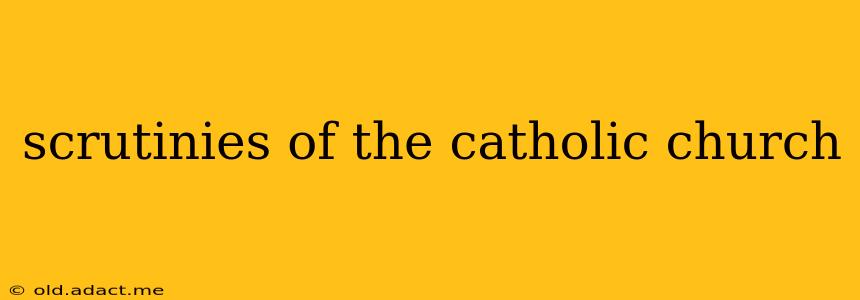The Catholic Church, one of the world's oldest and largest religious institutions, has throughout its history been subject to various scrutinies. These examinations range from theological debates and internal reforms to external criticisms concerning its doctrines, practices, and historical actions. This exploration delves into the multifaceted nature of these scrutinies, examining both historical and contemporary perspectives.
What are the main criticisms of the Catholic Church?
Criticisms of the Catholic Church are diverse and span centuries. Some of the most prominent include:
-
Doctrinal issues: The Church's stances on topics like contraception, abortion, homosexuality, and the role of women have drawn significant criticism from both within and outside the faith. These critiques often center on perceived inconsistencies with modern ethical frameworks and scientific understanding.
-
Historical controversies: The Church's historical involvement in events like the Crusades, the Inquisition, and the suppression of scientific inquiry continues to be a source of contention. Critics argue these actions demonstrate a pattern of violence, intolerance, and opposition to intellectual progress.
-
Abuse scandals: The widespread sexual abuse of children by clergy and the Church's subsequent handling (or mishandling) of these cases have been devastating to its credibility. These scandals have led to widespread calls for greater accountability and transparency.
-
Financial practices: Concerns about the Church's financial dealings, including the accumulation of wealth and alleged financial mismanagement, have also been raised. Transparency regarding financial resources and their allocation remains a subject of debate.
-
Political influence: The Church's historical and ongoing influence in politics, particularly in certain regions, has been criticized as an interference in secular affairs and a potential impediment to social justice.
What are some historical examples of scrutiny of the Catholic Church?
Throughout history, various movements and individuals have challenged the Church's authority and doctrines. The Protestant Reformation, spearheaded by Martin Luther, is a prime example of a major historical scrutiny, leading to a significant schism within Christianity. The Enlightenment also saw critiques of the Church's influence on societal structures and intellectual freedom. Furthermore, the rise of secularism and scientific advancements challenged the Church's traditional explanations of the world.
How does the Catholic Church respond to criticism?
The Catholic Church's responses to criticism have varied across time and context. In some instances, it has engaged in dialogue and reform, adapting its doctrines and practices to address concerns. The Second Vatican Council (Vatican II) in the mid-20th century represents a significant effort at internal reform and dialogue with the modern world. However, in other instances, the Church has been less receptive to criticism, maintaining traditional doctrines and practices despite external pressures. The Church's approach often depends on the specific issue, the context in which it arises, and the perceived threat to its authority.
What reforms has the Catholic Church implemented in response to scrutiny?
Following the widespread sexual abuse scandals, the Church has implemented various reforms aimed at enhancing accountability and protecting children. These include stricter background checks for clergy, mandatory reporting policies, and increased efforts to provide support for victims. However, the effectiveness and scope of these reforms remain a subject of ongoing debate and scrutiny.
What is the future of scrutiny of the Catholic Church?
Given the Church's global reach and enduring influence, it is highly likely that scrutiny will continue. Ongoing debates surrounding ethical issues, historical controversies, and issues of transparency and accountability will likely remain central to these discussions. The Church's ability to adapt and respond to these critiques will play a significant role in shaping its future. Furthermore, the rise of new social and technological changes will inevitably introduce new avenues for scrutiny.
How does the Catholic Church's teachings affect its scrutiny?
The Catholic Church’s teachings, particularly those concerning moral and ethical issues, often become focal points of scrutiny. Controversial doctrines can trigger intense debate and criticism, particularly in the context of evolving societal norms and scientific understanding. The inherent tension between tradition and modernity within the Church fuels ongoing scrutiny.
This overview provides a broad perspective on the numerous scrutinies facing the Catholic Church. Understanding these multifaceted challenges requires a nuanced approach, acknowledging both the historical context and the contemporary implications of these criticisms. The ongoing dialogue and debate surrounding these issues are crucial for the Church’s future and its relationship with the world.
